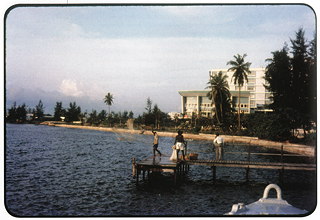Nuclear family and nuclear war
One iconic image of the Cold War era might be freshly scrubbed schoolchildren ducking under their desks for an atomic bomb drill.

The juxtaposition of obedient faith in nationhood and acknowledgement of potential annihilation typifies the complexity and contradictions of the Cold War era. Similar contradictions captured through the lens of Warren Langford are scrutinized in the just-published book A Cold War Tourist and His Camera. The civil servant travelled through North America, Africa and Europe as part of the National Defence College’s Cold War training in the early 1960s.
While away, he snapped 200 pictures – an incongruous mixture of tourist views and military installations – intended as illustrations of his travels for his wife and four children back in Canada. They have been re-examined by two of those children: Martha Langford, who holds the Concordia University Research Chair in Art History, and John Langford, a political science professor in the School of Public Administration at the University of Victoria. The pair has mined the photos as an almost accidental, extremely personal window into the politics of the time. Their volume has just been published by McGill-Queen’s University Press and will be launched as part of Concordia’s Speaking of Photography lecture series on March 15.
“I remember those slide shows. I found them fascinating,” recalls Langford, acknowledging that her older brothers, already sensing a countercultural pull, were less enthusiastic. She adds that although her father was not “bombastic, he was a civil servant, a government man, who swallowed whole the Cold War messages.”

Martha Langford has previously analyzed private photo albums as vernacular in her book Suspended Conversations: The Afterlife of Memory in Photographic Albums. Taking up ideas drawn from storytelling and other more ephemeral forms of visual culture, Langford analyzed intersections of image, history and memory in that volume, arguing for the broader significance of such personal mementos. It was her brothers who urged her to apply the “findings of Suspended Conversations and write something more personal that would provoke people to look at their own pictures.”
When the Langfords’ mother passed away and Martha became the caretaker of the slides that her father had presented with fanfare during her childhood, the project became much more concrete. “As I began to sift through the photographs, I realized I would need a lot of recourse to John.” He readily agreed to participate in the project.
The duo’s combined expertise adds richness to the analysis. “Often, when researchers use other approaches, they run with the affinities, not the most demanding, or up-to-date aspects of the other discipline.” However, the volume represents a concerted effort to contextualize the era, and the trip itself. The pair relied on information about the training program their father had participated in, along with material about Canada’s role in the Cold War. Although the photographs were not carefully labelled, they illustrated the tour, which ran over the winter and spring of 1963.
Ultimately, it was not the siblings’ differing perspectives that led to conflicting interpretations, but their differing approaches. “John insisted it was about the pictures, but I was equally interested in what wasn’t in the pictures,” says Langford.

While intrigued by the photographs themselves, Martha Langford was interested in what wasn’t documented, what was outside of frame or what was indicated about social customs by the photos. There were rules governing the exchange of images (you take a shot of me, I return the gesture), sharing of duplicates, etc. There were also limits to what Warren Langford was allowed to photograph, and of course, what he was told about the places he visited.
And Warren Langford himself was not really a photographer; his daughter describes him as a “snapshooter.” His interest in the practice coincided with this experience and did not extend long after. The two authors have published a layered, complex analysis of this accidental documentarian, one which Langford says they could not have produced if he were still alive.
Although primarily a collection of colourful marketplaces, impressive landmarks and spectacular views, some of the images carry unintended meaning. Langford’s view of Tahrir Square in Cairo from his Hilton Hotel window taken in the spring of 1963 is echoed in the current images of that square taken from similar vantage points. “It made the book feel really timely. The Globe and Mail recently said that the end of the Cold War is playing out in Tahrir Square,” adds Langford.
Both authors will be on hand for the lecture and book launch at 6:30 p.m. on March 15 in the York Amphitheatre, Room EV-1.615, Engineering, Computer Science and Visual Arts Integrated Complex (1515 St. Catherine St. W.).
Related links:
• A Cold War Tourist and His Camera
• Speaking of Photography series
• Concordia Department of Art History
• "Cold War is hot topic" - Concordia NOW, March 2, 2011